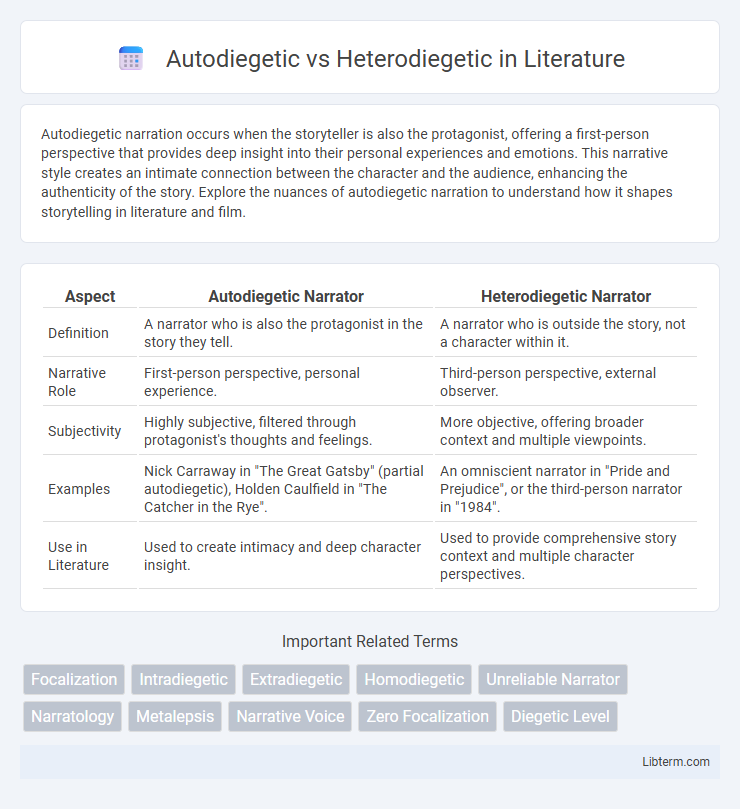Autodiegetic narration occurs when the storyteller is also the protagonist, offering a first-person perspective that provides deep insight into their personal experiences and emotions. This narrative style creates an intimate connection between the character and the audience, enhancing the authenticity of the story. Explore the nuances of autodiegetic narration to understand how it shapes storytelling in literature and film.
Table of Comparison
| Aspect | Autodiegetic Narrator | Heterodiegetic Narrator |
|---|---|---|
| Definition | A narrator who is also the protagonist in the story they tell. | A narrator who is outside the story, not a character within it. |
| Narrative Role | First-person perspective, personal experience. | Third-person perspective, external observer. |
| Subjectivity | Highly subjective, filtered through protagonist's thoughts and feelings. | More objective, offering broader context and multiple viewpoints. |
| Examples | Nick Carraway in "The Great Gatsby" (partial autodiegetic), Holden Caulfield in "The Catcher in the Rye". | An omniscient narrator in "Pride and Prejudice", or the third-person narrator in "1984". |
| Use in Literature | Used to create intimacy and deep character insight. | Used to provide comprehensive story context and multiple character perspectives. |
Understanding Narrative Perspectives
Autodiegetic narrators are characters who tell their own story from a first-person perspective, providing intimate insights into their thoughts and experiences within the narrative world. Heterodiegetic narrators exist outside the story they narrate, offering an external, often third-person viewpoint that can encompass multiple characters and events beyond the protagonist's knowledge. Understanding these distinctions enhances comprehension of narrative reliability, focalization, and the subjective versus objective presentation of events in literary analysis.
Defining Autodiegetic Narration
Autodiegetic narration occurs when the narrator is also the protagonist of the story, providing a first-person perspective that offers intimate access to their thoughts and experiences. This self-narration blurs the lines between the storyteller and the central character, enabling a subjective and immersive storytelling approach. Autodiegetic narrators contrast with heterodiegetic narrators, who exist outside the story's events and offer a more detached, third-person viewpoint.
Exploring Heterodiegetic Narration
Heterodiegetic narration occurs when the storyteller exists outside the story world, providing an omniscient perspective that offers a comprehensive understanding of characters and events. This narrative style enhances plot complexity by allowing insight into multiple characters' thoughts and motivations, creating a more layered and dynamic storytelling experience. Heterodiegetic narrators often employ third-person pronouns and can offer commentary or analysis, distinguishing their voice from the story's internal characters.
Key Differences Between Autodiegetic and Heterodiegetic
Autodiegetic narrators actively participate in the story they tell, offering a first-person perspective and personal insights that influence narrative reliability. Heterodiegetic narrators, in contrast, exist outside the story world, providing an external, often omniscient viewpoint that shapes the reader's understanding without direct involvement. The key difference lies in narrative perspective and presence: autodiegetic narration is character-centered and subjective, while heterodiegetic narration is detached and generally more objective.
Functions of the Narrator in Each Perspective
Autodiegetic narrators, as first-person storytellers, provide an intimate and subjective account, shaping the narrative with personal emotions and perspectives while actively participating in the story's events. Heterodiegetic narrators, positioned outside the story, offer an objective, omniscient viewpoint that can reveal multiple characters' thoughts and provide broader contextual insight. The function of the autodiegetic narrator centers on deepening character development through internal reflection, while the heterodiegetic narrator structures the narrative by maintaining clarity, coherence, and an overarching thematic framework.
Reader Engagement and Narrative Voice
Autodiegetic narrators, who tell their own story, create deep reader engagement by offering intimate access to their thoughts and emotions, enhancing narrative authenticity and emotional investment. Heterodiegetic narrators, external to the story, provide broader perspectives and detailed world-building, which can engage readers through objectivity and expansive storytelling. The choice between autodiegetic and heterodiegetic narrative voices significantly influences reader immersion, shaping how audiences connect with characters and interpret the plot.
Literary Examples of Autodiegetic Narrators
Autodiegetic narrators, who are both the protagonist and the storyteller, create an intimate subjective perspective found in literary examples such as Holden Caulfield in J.D. Salinger's *The Catcher in the Rye* and Nick Carraway in F. Scott Fitzgerald's *The Great Gatsby*. These narrators provide personal insights and direct involvement in the plot, enhancing reader connection to the unfolding events. Their self-referential storytelling contrasts with heterodiegetic narrators, who remain outside the story world and offer an external viewpoint.
Literary Examples of Heterodiegetic Narrators
Heterodiegetic narrators appear outside the story's action, providing an external perspective that offers a comprehensive overview of events and characters. Classic examples include the third-person omniscient narrator in Jane Austen's *Pride and Prejudice* and the detached narrator of Leo Tolstoy's *War and Peace*, both delivering insights beyond any single character's experience. This narrative mode enhances objectivity and broadens the reader's understanding by encompassing multiple viewpoints within the literary work.
Impact on Storytelling and Plot Development
Autodiegetic narrators, who tell their own story, create a deeply subjective perspective that enhances emotional engagement and adds complexity to plot development by limiting information to their personal experiences. Heterodiegetic narrators, recounting stories where they are not characters, provide a broader, more objective view that allows for multiple viewpoints and a comprehensive understanding of events, which can drive intricate plot structures and a layered narrative. The choice between autodiegetic and heterodiegetic narration significantly shapes the storytelling approach, influencing the depth of character insight and the scope of plot revelation.
Choosing the Right Narrative Style
Choosing the right narrative style involves understanding the distinction between autodiegetic and heterodiegetic narrators; an autodiegetic narrator participates as the story's protagonist, providing intimate, subjective insights, while a heterodiegetic narrator remains external, offering a broader, more objective perspective. Autodiegetic narration enhances emotional engagement by presenting personal experiences and internal thoughts, making it ideal for character-driven stories. Heterodiegetic narration suits complex plots requiring multiple viewpoints and comprehensive world-building, ensuring clarity and scope within the narrative.
Autodiegetic Infographic

 libterm.com
libterm.com